It begins with an elderly lady alone on a black stage watching the news headlines on television, with Australia’s bushfires one of the images featured. Clearly about to die, she climbs slowly into bed and gradually disappears beneath the blanket, as her furniture is covered in funereal black drapes. It ends with a little baby alone on stage, happily playing with a toy, its unspoilt innocence glowing against the soil-stained, white stage. Yet the baby will, we know, inevitably die too at some point in the future.
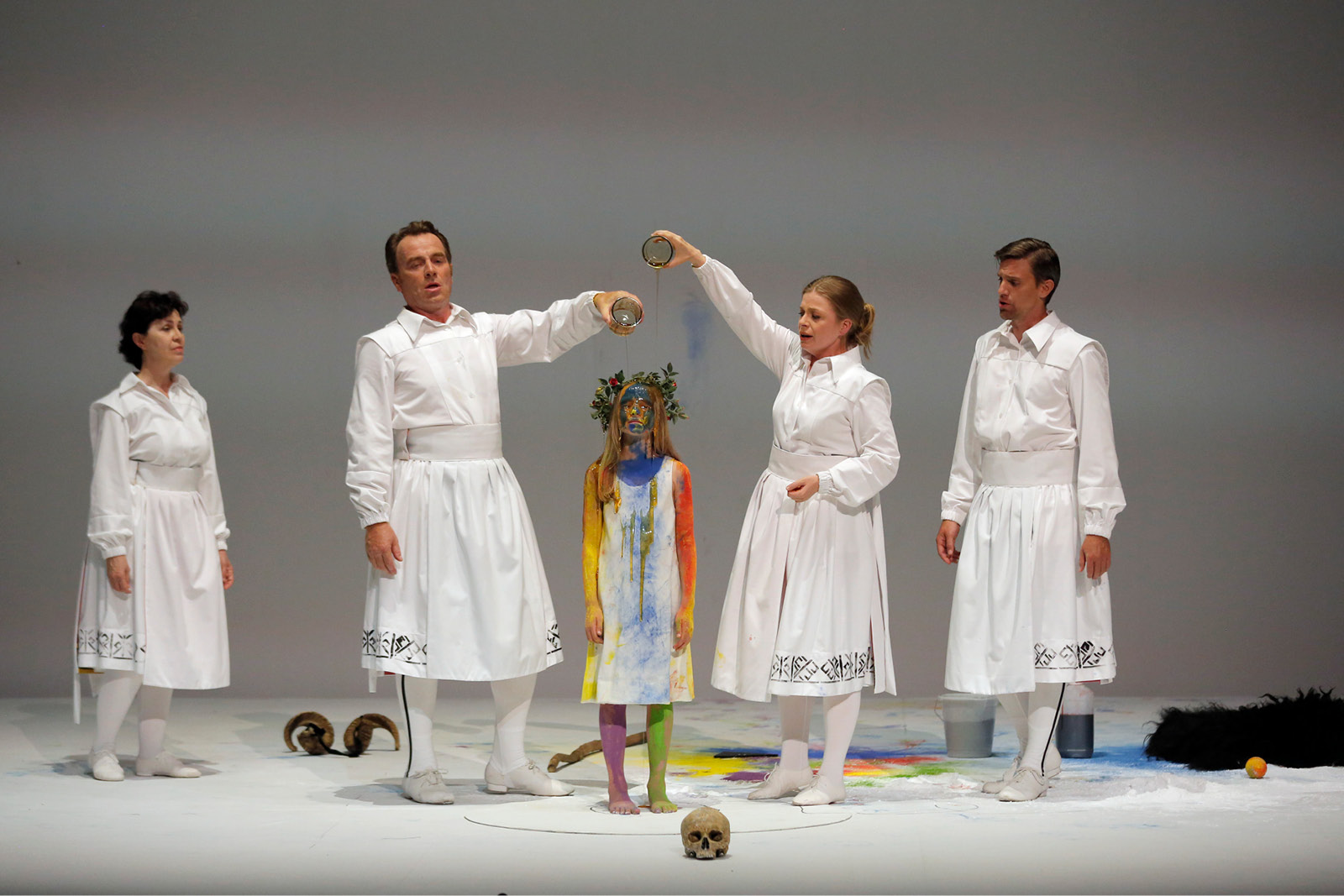
In between this cycle of life, director Romeo Castellucci fills his beautiful, radical, complex, provocative staging of Mozart’s Requiem with joyous folkloric dancing, striking, surreal imagery, and blasts of colour amid the dark shadows. But however vibrant the staging becomes, extinction is always there in the background. A list called ‘Atlas of Great Extinctions’ projected onto the back wall scrolls through the names of the wildlife, human species, languages, buildings, artworks, religions and other things that have become extinct, from dinosaurs to the Hanging Gardens of Babylon to glaciers to the World Trade Centre. Eventually it includes “friendship”, “tears”, “faith” and “wonder”, ending with the date of the particular performance you are seeing, now gone. After the recent catastrophic bushfires and floods in Australia, the extinction of mankind as a result of climate change feels all too possible. And yet the baby remains a sign of hope and renewal, symbolising the future.
Requiem premiered at the Festival d’Aix-en-Provence last July to rave reviews. Co-produced with Adelaide Festival and several other arts organisations, it is the first of three major operatic productions to arrive in Adelaide from Aix-en-Provence as result of the co-commissioning agreement. It is a perfect festival event and an exciting way to start this year’s Adelaide Festival.
Castellucci created his production with conductor Raphaël Pichon, who conducted it in Aix. Mozart, of course, died before finishing the superlative Requiem in D Minor, commissioned by the eccentric Count Franz von Walsegg (who was known for passing off the works of other composers as his own) in memory of his 20-year-old wife Anna. Mozart stopped work while composing the glorious Lacrimosa – which Castellucci acknowledges in a powerful piece of staging, best not to reveal – so his wife Constanze asked his pupil Franz Xavier Süssmayr, who had apparently had detailed discussions with Mozart about the Requiem, to complete it.
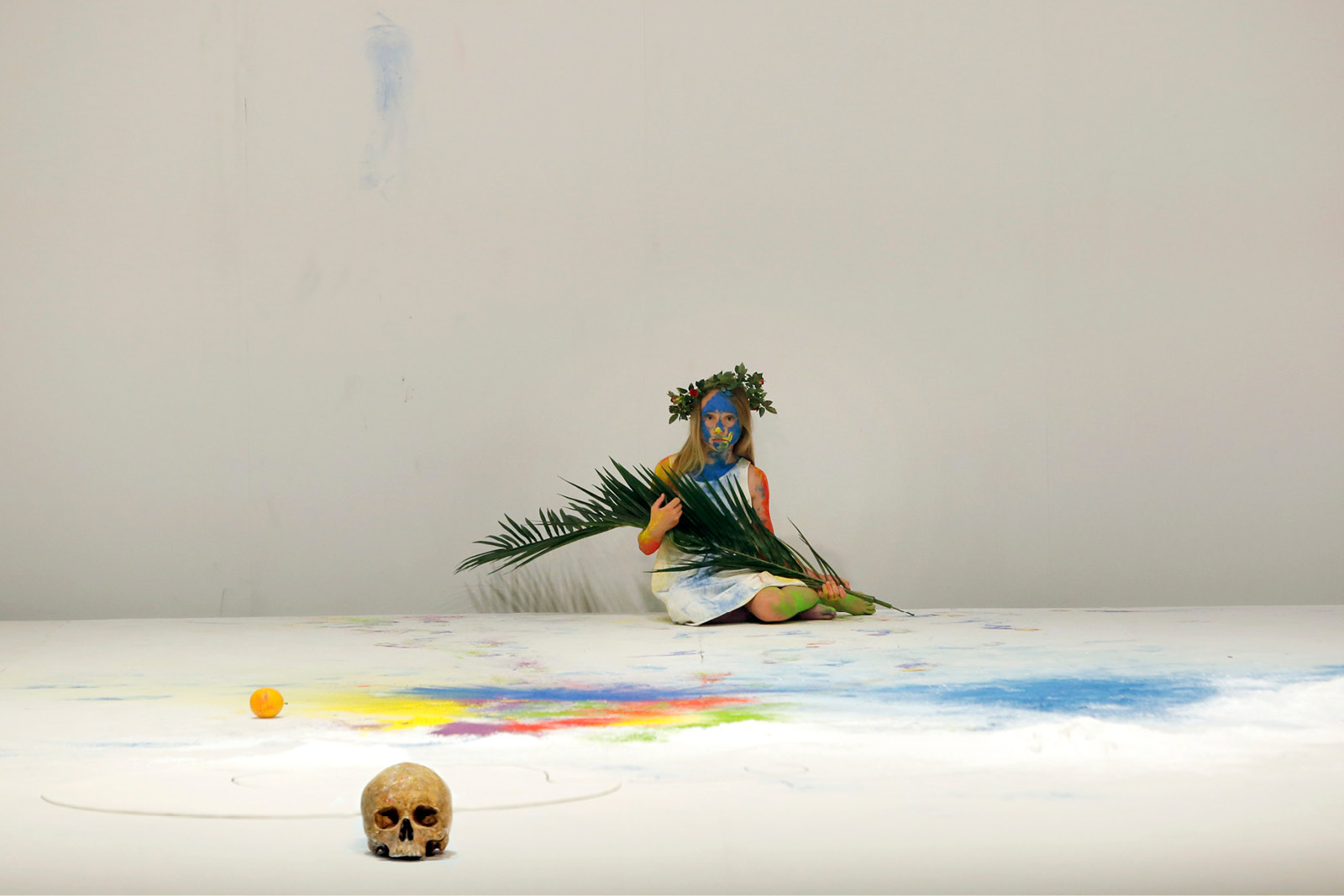
This is the version used, to which Pichon has added other music: Gregorian plainchant at the beginning and end, as well as rare pieces of Mozart’s music inserted between movements, including the Meistermusik (a Masonic hymn), the Miserere Mei, K.90 originally composed for a requiem Kyrie, a Solfeggio which opens his Mass in C Minor, and the song O Gottes Lamm (Lamb of God) among them. Musically it works wonderfully well, performed here by the Adelaide Symphony Orchestra under the baton of Rory Macdonald (who spent time at the rehearsals in Aix-en-Provence).
The four soloists in Adelaide include three who performed in Aix-en-Provence: Australian soprano Siobhan Stagg, Italian alto Sara Mingardo and Austrian tenor Martin Mitterrutzner, who are joined here by Australian baritone David Greco in the bass role. Young Australian treble Luca Shin also performs two pieces.
The Australian production features the Adelaide Festival Chorus (which includes members of Adelaide Chamber Singers and State Opera Chorus), under Chorus Master Brett Weymark, as well as dancers from Australian Dance Theatre.
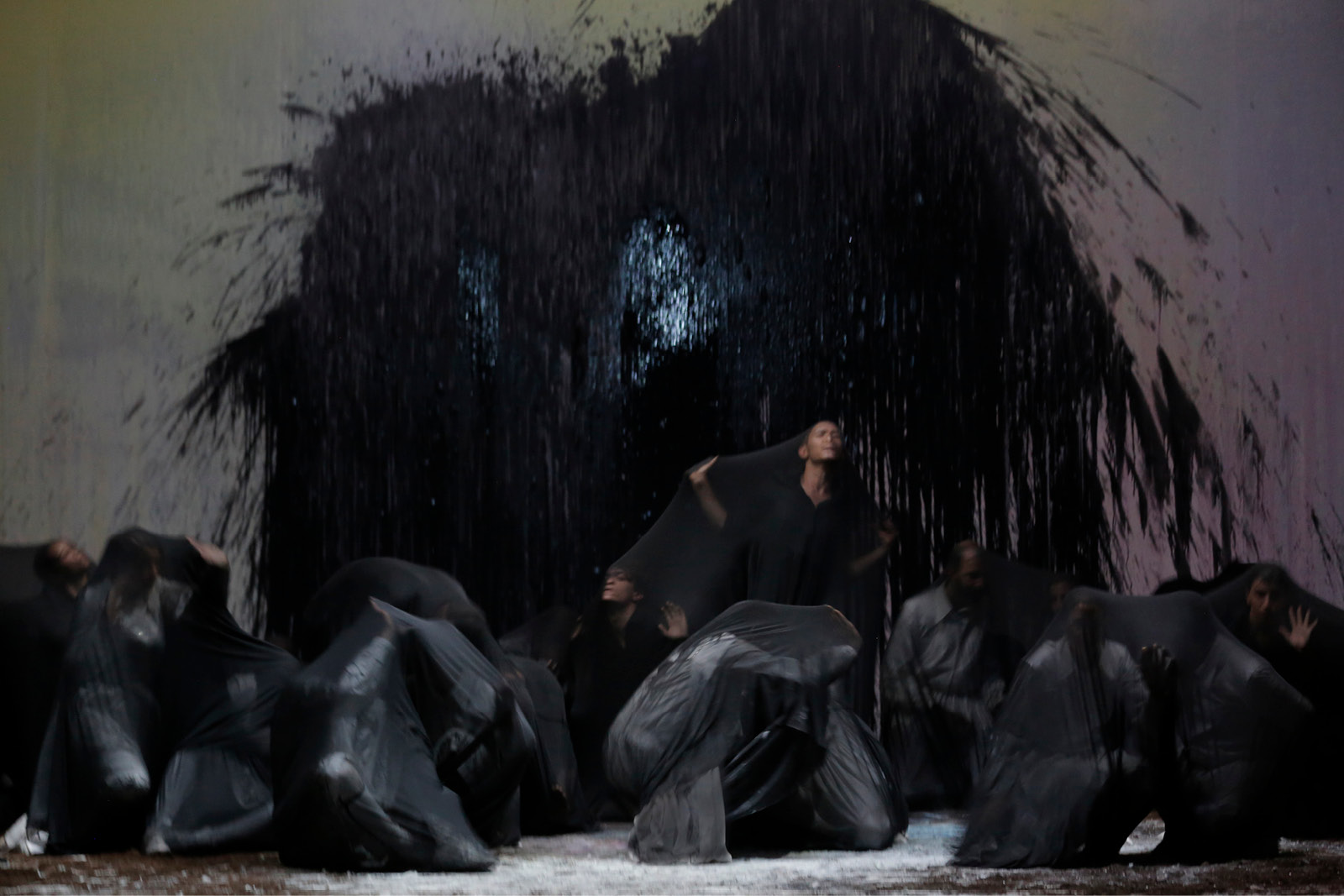
As well as conceiving and directing the production, Castellucci also designed the set, costumes and lighting. The production moves from a black space to a white box into which Castellucci gradually injects vivid colours in the form of paint, vibrant costumes, and props from green trees to ribboned may poles, as well as soil which gradually dirties the stage. There are several stunning coups de théâtre. At one point, the white back wall is ripped away to be replaced by a black background, and at the end of the production, the white floor of the stage is slowly elevated. As it rises, the soil and white clothing that the chorus has shed slide down it as if the past is being obliterated – though not entirely – and the future reborn.
The ritualistic staging features plenty of folkloric dancing performed primarily by the chorus along with the ADT dancers, and the soloists on occasion. At times the juxtaposition of the dancing (choreographed by Evelin Facchini), which symbolises community and the vitality of life, seems at odds with the music and what is being sung. Folk dancing to the fierce Dies irae? It sounds strange and yet as the production unfolds you gradually accept the premise – that Castellucci is portraying, accepting and celebrating the transience of life. The scenes of dancing then start to feel both joyous and poignant.
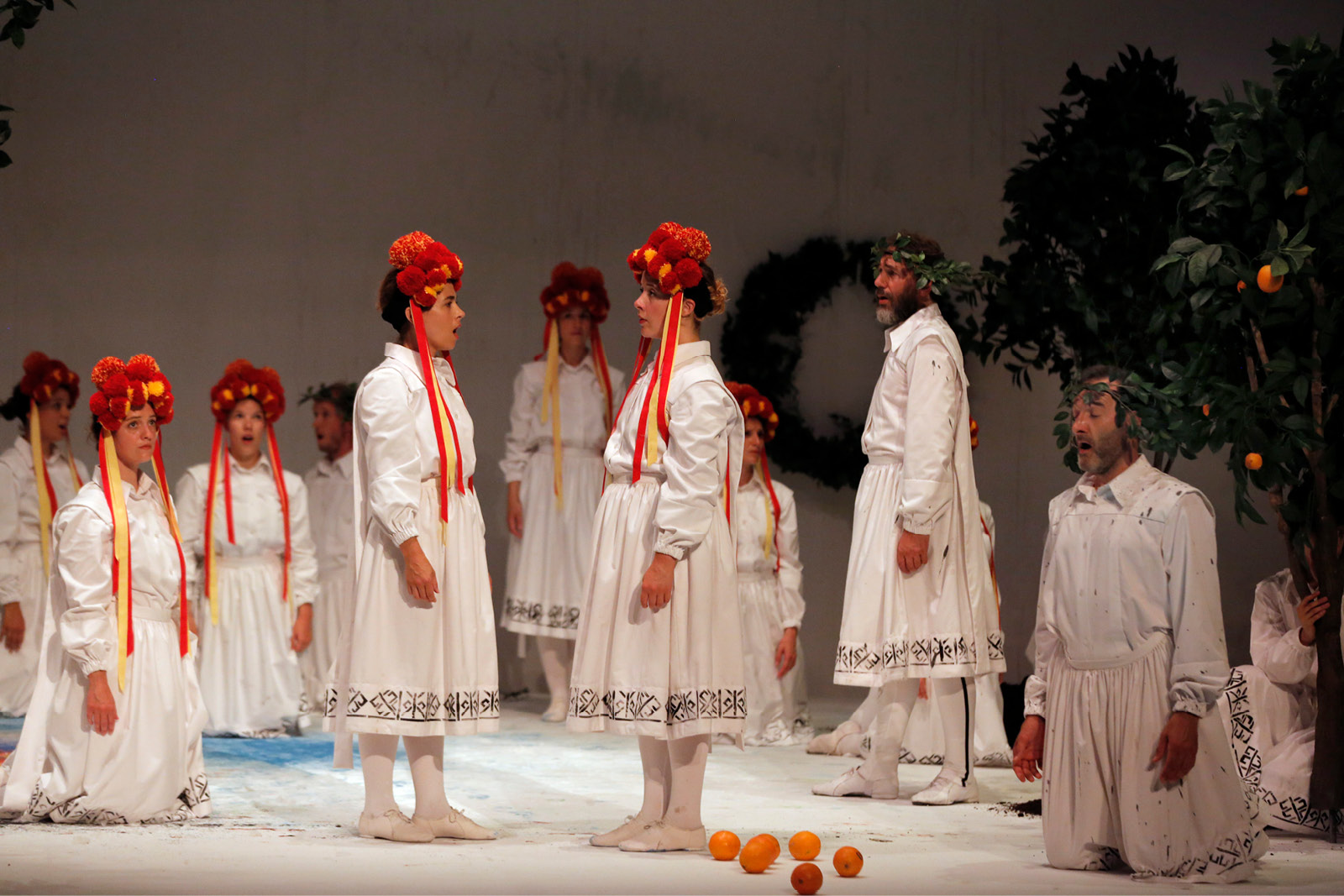
Castellucci uses three women of different ages as the production goes backwards in time. The elderly woman (Chrissie Page) who dies at the stage, but then reappears, is joined by her younger self (Jacinta Hriskin), who falls from the bed when it is lifted up to be removed from the stage, and a little girl (Mietta Brookman). Sometimes we see them together, three-in-one, at other times we watch them separately.
The imagery used throughout the production is always striking, though sometimes you wonder what to make of it. The anointing of the young girl with honey and coloured fluids poured over her head, with feathers and dust then thrown at her, is strange and disturbing. The way she then hangs from the walls by her arms is an image I won’t quickly forget. In fact, I felt anxious until she was lifted down.
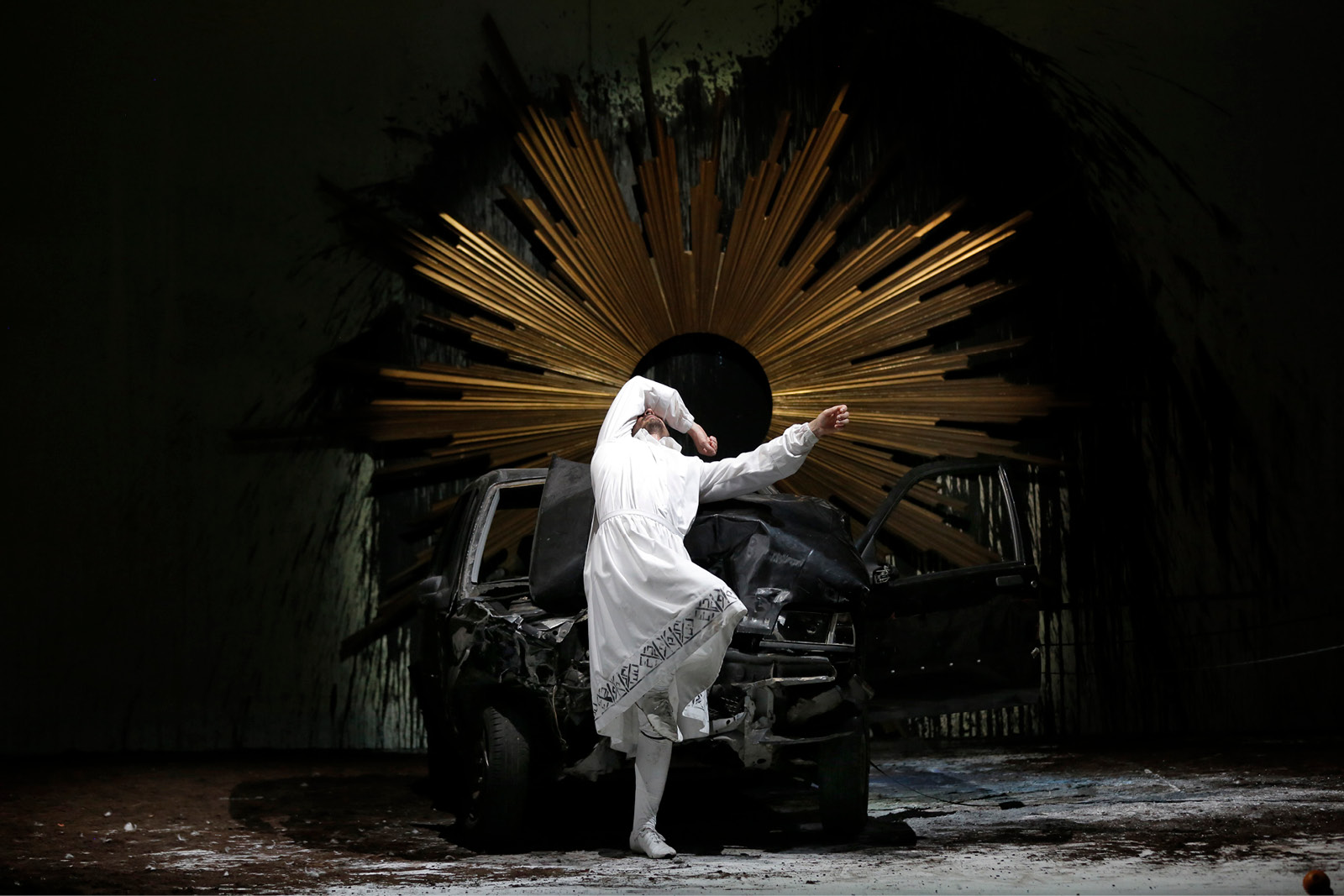
The smashed-up car instantly summons images of cars burned out in the recent bushfires. The way chorus members stand in front of the bonnet then reel back as if terrified by the headlights of an approaching car, before lying in a line on the stage, certainly summons the idea of death. Other images include a forest, a crucifixion and the young treble kicking a skull as if it’s a football. At times it feels as if scenes distract from the music, at other times it seems to fit like a glove.
Musically the production is richly satisfying, with the soloists bringing a clarity and simplicity to their vocals. Mingardo’s alto is gorgeous, and her performance of O Gottes Lamm is one of the evening’s musical highlights. Stagg sings with a lovely, silvery tone, Mittterrutzner’s tenor is youthful and bright, and Greco brings warmth and depth to his darker vocals. The chorus, meanwhile, do a wonderful job of handling the physicality of the dancing on top of their singing.
The production ends with the young treble Luca Shin standing in a spotlight in the auditorium in front of the pit singing a Gregorian hymn In paradisium (In paradise), traditionally sung at the end of a Catholic funeral, He is then joined by the chorus and orchestra as the baby sits alone on stage. It’s a beautiful, touching conclusion to a production that is stunning, intriguing and disconcerting. Does it all work? Does it really evoke a Requiem? In the end, I think it does. It is certainly an extraordinary production with images that will sear themselves into your memory and leave you with plenty to ponder about life and death. Jo Litson
Requiem plays at the Festival Theatre, Adelaide Festival Centre until March 4











Comments
Log in to join the conversation.